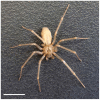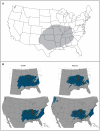Tracking a medically important spider: climate change, ecological niche modeling, and the brown recluse (Loxosceles reclusa)
- PMID: 21464985
- PMCID: PMC3064576
- DOI: 10.1371/journal.pone.0017731
Tracking a medically important spider: climate change, ecological niche modeling, and the brown recluse (Loxosceles reclusa)
Abstract
Most spiders use venom to paralyze their prey and are commonly feared for their potential to cause injury to humans. In North America, one species in particular, Loxosceles reclusa (brown recluse spider, Sicariidae), causes the majority of necrotic wounds induced by the Araneae. However, its distributional limitations are poorly understood and, as a result, medical professionals routinely misdiagnose brown recluse bites outside endemic areas, confusing putative spider bites for other serious conditions. To address the issue of brown recluse distribution, we employ ecological niche modeling to investigate the present and future distributional potential of this species. We delineate range boundaries and demonstrate that under future climate change scenarios, the spider's distribution may expand northward, invading previously unaffected regions of the USA. At present, the spider's range is centered in the USA, from Kansas east to Kentucky and from southern Iowa south to Louisiana. Newly influenced areas may include parts of Nebraska, Minnesota, Wisconsin, Michigan, South Dakota, Ohio, and Pennsylvania. These results illustrate a potential negative consequence of climate change on humans and will aid medical professionals in proper bite identification/treatment, potentially reducing bite misdiagnoses.
Conflict of interest statement
Figures






Similar articles
-
Distribution of the brown recluse spider (Araneae: Sicariidae) in Georgia with comparison to poison center reports of envenomations.J Med Entomol. 2009 Jan;46(1):15-20. doi: 10.1603/033.046.0103. J Med Entomol. 2009. PMID: 19198513
-
Arachnids submitted as suspected brown recluse spiders (Araneae: Sicariidae): Loxosceles spiders are virtually restricted to their known distributions but are perceived to exist throughout the United States.J Med Entomol. 2005 Jul;42(4):512-21. doi: 10.1093/jmedent/42.4.512. J Med Entomol. 2005. PMID: 16119538 Review.
-
Reports of envenomation by brown recluse spiders (Araneae: Sicariidae) outnumber verifications of Loxosceles spiders in Florida.J Med Entomol. 2004 Jul;41(4):593-7. doi: 10.1603/0022-2585-41.4.593. J Med Entomol. 2004. PMID: 15311449
-
Matching global and regional distribution models of the recluse spider Loxosceles rufescens: to what extent do these reflect niche conservatism?Med Vet Entomol. 2018 Dec;32(4):490-496. doi: 10.1111/mve.12311. Epub 2018 Jun 8. Med Vet Entomol. 2018. PMID: 29884992
-
Identifying and misidentifying the brown recluse spider.Dermatol Online J. 1999 Nov;5(2):7. Dermatol Online J. 1999. PMID: 10673460 Review.
Cited by
-
A new species of Loxosceles Heineken & Lowe (Araneae, Sicariidae), with updated distribution records and biogeographical comments for the species from Mexico, including a new record of Loxoscelesrufescens (Dufour).Zookeys. 2018 Dec 4;(802):39-66. doi: 10.3897/zookeys.802.28445. eCollection 2018. Zookeys. 2018. PMID: 30568529 Free PMC article.
-
Climate Change, Extreme Temperatures and Sex-Related Responses in Spiders.Biology (Basel). 2023 Apr 18;12(4):615. doi: 10.3390/biology12040615. Biology (Basel). 2023. PMID: 37106814 Free PMC article. Review.
-
Androctonus genus species in arid regions: Ecological niche models, geographical distributions, and envenomation risk.Vet World. 2018 Mar;11(3):286-292. doi: 10.14202/vetworld.2018.286-292. Epub 2018 Mar 6. Vet World. 2018. PMID: 29657418 Free PMC article.
-
Projecting distribution of the overwintering population of Sogatella furcifera (Hemiptera: Delphacidae), in Yunnan, China with analysis on key influencing climatic factors.J Insect Sci. 2015 Oct 22;15(1):148. doi: 10.1093/jisesa/iev131. Print 2015. J Insect Sci. 2015. PMID: 26494777 Free PMC article.
-
Predicting the distributions of Egypt's medicinal plants and their potential shifts under future climate change.PLoS One. 2017 Nov 14;12(11):e0187714. doi: 10.1371/journal.pone.0187714. eCollection 2017. PLoS One. 2017. PMID: 29136659 Free PMC article.
References
-
- Swanson DL, Vetter RS. Bites of brown recluse spiders and suspected necrotic arachnidism. N Engl J Med. 2005;352:700–707. - PubMed
-
- Binford GJ, Cordes MHJ, Wells MA. Sphingomyelinase D from venoms of Loxosceles spiders: evolutionary insights from cDNA sequences and gene structure. Toxicon. 2005;45:547–560. - PubMed
-
- Van Meeteren LA, Fredricks F, Giepmans BNG, Pedrosa MF, Billington SJ, et al. Spider and bacterial sphingomyelinase D target cellular lysophosphatidic acid receptors by hydrolyzing lysophosphatidylcholine. J Biol Chem. 2004;279:10833–10836. - PubMed
-
- Vetter RS. Spiders of the genus Loxosceles (Araneae, Sicariidae): a review of biological, medical and psychological aspects regarding envenomations. J Arachnol. 2008;36:150–163.
-
- Glenn JB, Lane JE, Clark EK. Arachnid envenomation from the brown recluse spider. Clin Pediatr. 2003;42:567–570. - PubMed
MeSH terms
LinkOut - more resources
Full Text Sources
Medical

